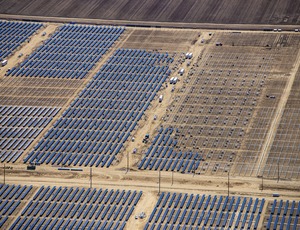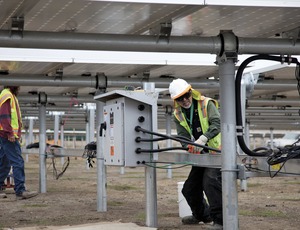

When the $2.2-billion, 377-MW Ivanpah Solar Electric Generating System in California's Mojave Desert commenced commercial operation in December 2013, the facility became the world's largest solar-thermal powerplant. At a stroke, it also doubled installed U.S. solar-thermal generation capacity.
 |
BrightSource Energy Inc., Ivanpah's solar technology provider, declined to comment, but statistics show the solar-power market belongs to PV. According to the Solar Electric Industries Association (SEIA), of 5,725 MW of solar projects under construction, 24% consist of concentrating solar power, another name for thermal, but only 16% of the capacity of solar projects in development is CSP, portending a major loss of market share.
The Solar Star project near Rosamond, Calif., claims to be the world's largest permitted solar PV development. At 579 MW, the vast ground-mounted, single-axis PV project dwarfs Ivanpah. San Jose-based SunPower developed the project, sold it to Mid- American Solar, Phoenix, and now is the EPC lump-sum contractor, says Jorg Heinemann, SunPower's executive vice president of customer operations and engineering, procurement and construction. He pegs the construction value between $2 billion and $2.5 billion. Construction began in early 2013 and is on schedule for completion by the end of 2015.
Smaller plants also are proliferating. Mortenson Co., Minneapolis, was selected last year as EPC contractor to build five ground-mounted, dual-axis plants. They range from 6 to 100 MW, total 346 MW and will be built over three years for owner and developer OCI Solar Power, which has a 25-year power-purchase agreement with San Antonio's municipal utility, CPS Energy. Mortenson broke ground in January for the 40-MW first plant, near Brackettville, Texas, says Trent Mostaert, Mortenson's general manager, solar and emerging renewables group. The others will be in different locations near San Antonio.
Squeezing Out Costs
SEIA reports that PV installations increased a "record-shattering" 41% last year over 2012's level, helping make solar the second-largest source, after natural gas, of new generating capacity in the U.S. in 2013. The complaint about solar energy is that it needs subsidies, tax credits and renewables-portfolio standards to be viable. But market forces are driving down solar costs. "PV cells are a commodity," says Ric O'Connell, director of solar PV for Black & Veatch. Manufacturers are squeezing out costs with standard designs, and, in recent years, manufacturing has grown to 4,500 MW a year from 500 MW, O'Connell says. A PV-industry rule of thumb, called Swanson's Law, suggests PV-cell costs fall by 20% for each doubling of global manufacturing capacity or cumulative shipped volume. Chinese manufacturers have mastered this rule, provoking SolarWorld to petition for a tariff on imports of Chinese silicon panels.
Standardizing modules and processes has made PV installation almost as easy as building with TinkerToys. "There is much less work than on a gas-turbine combined-cycle plant," O'Connell says. "It's essentially like setting up a manufacturing facility in the field." The cost for an EPC solar project typically ranges from $1.50 per installed watt in a market such as Texas to $2.25 per watt in New England, says Mortenson's Mostaert. Larger jobs are less costly, and fixed tilts cost less than single- or double-axis trackers.
Also helping to reduce solar costs, the Dept. of Energy's SunShot Initiative works to make solar energy cost-competitive with conventional energy by 2020. In February, DOE announced that the average price for utility-scale PV generation has dropped to 11¢ per kilowatt-hour—below the average U.S. electricity price of about 12¢ per kWh—from about 21¢ per kWh. SunShot's target is 6¢/kWh by 2020.
The results are starting to show. At ENR press time, Austin Energy, owned by the city of Austin, Texas, had City Council approval to negotiate a 25-year power-purchase agreement with SunEdison Inc. for up to 150 MW from two solar farms to be built in West Texas. Long-term fixed pricing will be in the range of $45 to $55 per MWh, or 4.5¢ to 5.5¢ per kWh. These are among the lowest solar prices available anywhere in the solar industry today, Austin Energy says.

Post a comment to this article
Report Abusive Comment